Ray system design features. varieties with forced and
The efficiency of heating at home depends not only on the boiler and the selected models of radiators. No less important is how the circulation of the coolant between these devices is organized. And if earlier pipelines with a tee-joint method of connection were used, now radial distribution of the heating system is often used. Although it’s harder to do it yourself, the benefits and ease of use do not make you give up on your choice.

Design features
Radiation heating, unlike the tee-share, with which all the owners of city apartments and houses of the old building are familiar, provides for not connecting, but parallel connection of batteries to the heating boiler.
In this case, a special collector cabinet is installed, in which all the necessary control equipment, pumps, pressure gauges, taps, and so on are carefully installed.
The differences between the two installation schemes mentioned above are as follows:
- Tee wiring requires a much smaller number of pipes themselves, but when installing it, you need to use a lot of fittings: tees, shafts, couplings, and so on. This complicates the installation procedure. In addition, a consistent method of arrangement of the heating system is considered less reliable, since in this case there is a high probability of errors that will lead to depressurization, the formation of areas with different fluid pressure, and so on.
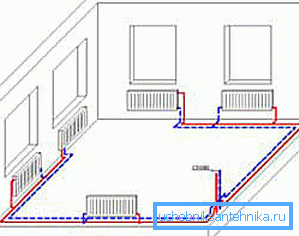
- The radial distribution of heating, despite the need to purchase a much larger number of pipes, uses only two connections for each radiator: at the junction with the collector and at the battery nozzle.
As a result, you can safely brick up each "beam" of the heating network to the floor, without fear that it will leak at any joint. In addition, if a breakdown is detected, you can easily turn off the problem area without disturbing the circulation of coolant through the heat exchange equipment installed in other rooms.
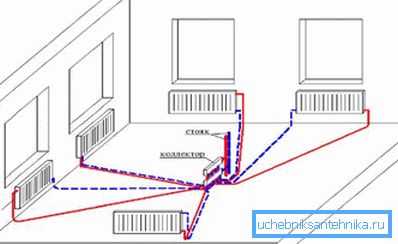
It should be noted that one of the main disadvantages of radial heating is its price. This is especially true of systems equipped with electrical equipment.
Note! As in the case of the T-system, the radial system provides for the organization of the natural (gravitational) and forced (with the help of pumps) coolant current.
Consider both types in more detail.
Radar Patterns
Method 1. With forced circulation of water
Previously, the radial heating circuit, equipped with pumps that pump water, was not very popular due to the high cost of parts. But at present, the price of equipment has decreased significantly, and an increasing number of people opt for it.
The main difference from the gravitational scheme is that the liquid (water or antifreeze) flows from the boiler to the batteries and back not due to the difference of temperature and pressure, but with the help of pumps.
Thanks to this, the following advantages are achieved:
- There are no restrictions on the geometry and number of rooms in the house building;
- heating can be installed in any area of the premises;
- pipes of any length, laid without a slope, can be used to connect radiators and collectors.
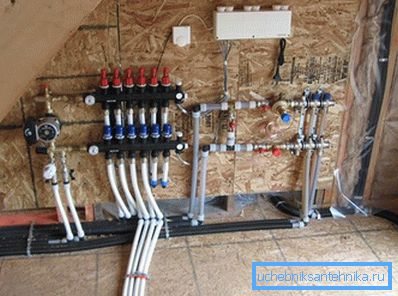
Tip! Despite the fact that the circulating pump can be installed at any point in the system, it is advisable to do this on the return manifold before supplying the coolant to the boiler. There the temperature of the liquid is the lowest, which positively affects the service life of the equipment.
Method 2. With the natural circulation of water
In this case, the coolant moves due to gravity: the heated water becomes less dense and lighter, therefore it is forced out to the upper point of the system, after which, as it cools, it flows through the collectors and radiators, and then returns to the heater.
Gravitational beam heating system has the following features:
- When installing, an open expansion tank is needed, which is installed at the highest point. It compensates for thermal expansion of the coolant and prevents an increase in internal pressure in the pipelines.
- Radiation heating network with natural circulation does not require the installation of expensive electrical equipment, which significantly reduces the estimated cost of work.
- Heating with natural circulation is completely non-volatile. Even if you turn off the electricity, which is often the case in the suburban areas or in the countryside, you will not be left without heat.
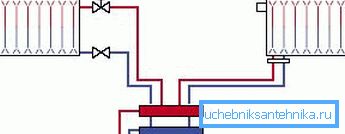
Advantages and disadvantages of radial heating systems
Positive sides
The main advantage of the radial scheme - ease of use.
Special equipment makes climate network management as ergonomic and convenient as possible:
- You can set the temperature of each radiator in the house without leaving the collector cabinet.. In addition, if necessary, you can completely shut off the water supply to any element of the system without affecting the performance of the entire heating network.
- Each pair of pipes connects the collector with only one radiator.. Therefore, you can use pipelines of small diameter, which are easy to disguise under the floor covering. In addition, it allows to partially warm the floor surface.
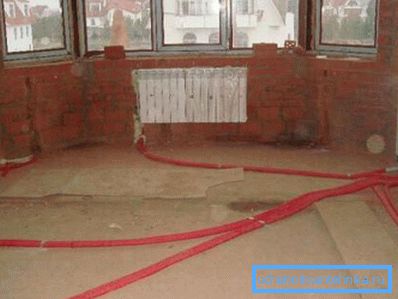
- Thanks to the use of special devices (the so-called hydro shooters - collectors with a large diameter) it is possible to form several heating zones in the house with different heat carrier temperatures.
In this case, a short circuit is organized between the supply and return pipes. Heated water is constantly circulating in the hydraulic needle, and its fence can be produced at different distances (the temperature will depend on it).
Negative sides
For completeness, it should be said about the minuses of the use of the radiant heating system.
It is because of them, despite all the advantages, it is not very common:
- Strongly increased flow of the supply and discharge pipes. The larger the house and the more complex the geometry of the rooms, the more details will be needed. In addition, the complexity of installation increases, which can not affect the estimated cost of construction.
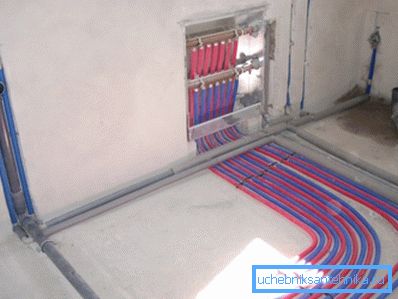
- The need for hidden installation. If the traditional tee-system can be mounted along the walls, then you cannot place a huge number of pipes this way. They must be hidden under the floor. You can wall up and in the walls, but in this case, the material consumption will increase even more.
- No joints. When designing pipelines, it is imperative to ensure that the pipe under the floor does not contain a single joint. In this place, gusts occur most often, and the cost of repairing the damage will be far from low and very laborious.
- If the system design includes several circuits with different coolant temperature, then each of them should be equipped with a circulation pump.
Installation Features
Any beam heating system for the home is designed and installed individually, depending on the area of the house, the number of rooms, the selected coolant and radiators, as well as other conditions.
However, there is a generally accepted instruction that every installer complies with.
First of all, it should be noted that the radial distribution of pipes is never done in city apartments. This is due to the fact that the flow of coolant in high-rise buildings is carried out through vertical risers connecting all apartments - from the first floor to the last.
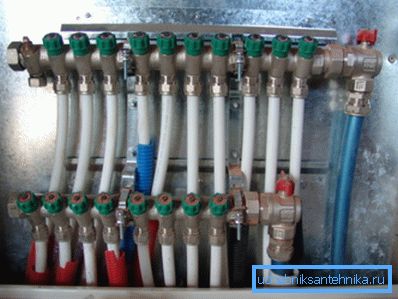
As a result of the connection of powerful collectors, hot water will not reach the premises located above, which will disrupt the operation of the heating network. Residents will complain to the service organization, which, sooner or later, will force you to dismantle the collectors, and return to the tee heating system.
Note! The above mentioned does not apply to cases when an autonomous boiler is used to heat an apartment. He independently heats the coolant, which will be enough to ensure the needs of the home, without affecting the interests of neighbors.
When arranging radial heating in a private house, it is necessary to pay attention to such nuances:
- On the collectors that supply and discharge water to the batteries, valves are installed that prevent the formation of air plugs. During operation, all the air remaining in the system will be released through them.

- The heating circuit must be equipped with an expansion tank, the volume of which is 10% of the amount of coolant circulating through the pipes. It is advisable to buy membrane containers of the closed type.
- It is advisable to install the tank on the pipeline that connects the discharge manifold to the boiler. This is due to the fact that the hermetic expansion tank does not like turbulent water flows, and they appear least often on the return pipe.

- In contrast to the expansion tank, the installation location of the circulation pumps is not so important. But it is also desirable to connect them to the pipe draining the cooled coolant. In this case, the equipment will work more time.
- During installation it is necessary to ensure that the shafts of electric pumps are located strictly horizontally. Otherwise, due to distortions, the bearings will quickly fail, and you will have to change or repair the equipment.
Conclusion
Despite all the advantages, the radiation method of organizing heating can not be attributed to budget decisions. However, the benefits obtained are undoubtedly worth the money and effort spent. It is only necessary to choose the right equipment so that it does not become the “bottleneck” of the system. You can learn more about this in the video in this article.